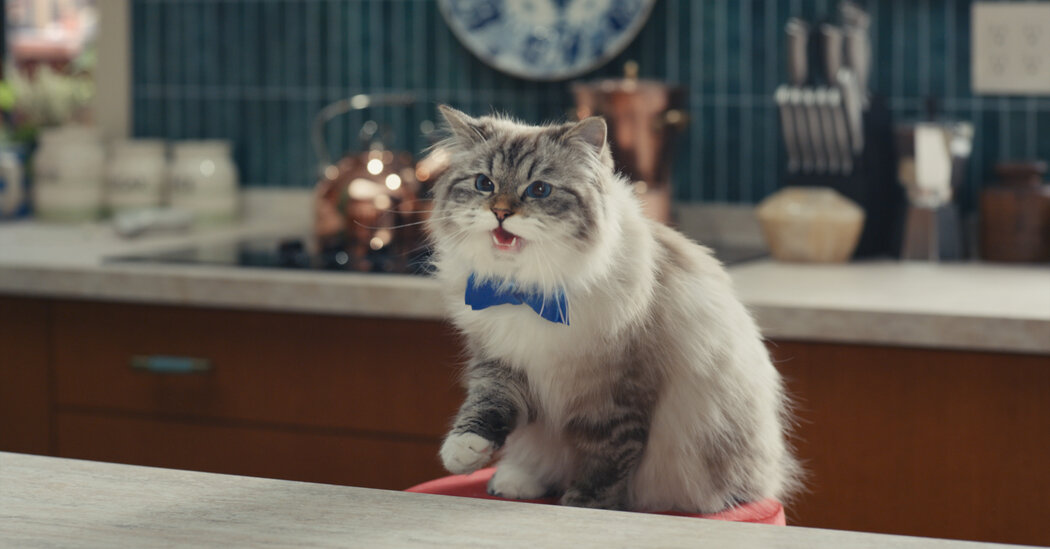A cat meowing for Hellmann’s mayonnaise, Peyton Manning chucking Bud Light beers to patrons in a bar and Kris Jenner stacking Oreo cookies. They all have one thing in common: Those companies paid seven figures to get their products in front of viewers during this year’s Super Bowl.
For the second consecutive year, the average cost of a 30-second ad spot during the Super Bowl was $7 million. Even as many businesses are being more disciplined with the money they have for marketing, and with spending on advertising slowing in recent years, the cost of a Super Bowl ad continues to go up.
The reason is simple: There is no opportunity guaranteed to reach more people than the Super Bowl, and the slice of every other pie keeps shrinking.
“It’s a throwback in terms of reaching everyone all at once,” said Charles Taylor, a professor of marketing at the Villanova School of Business.
In an increasingly fragmented media landscape, the number of opportunities for companies to reach a mass audience through advertising on network television has dwindled. Popular shows have increasingly moved to streaming platforms, along with audiences. More and more, networks find themselves relying on live events, like award shows and sports, to draw viewers.
“Live events are still huge for advertisers, and those are the ones that draw the highest attention,” said Frank McGuire, a vice president at Sharethrough, an advertising integration platform.
Not all live events are created equal, though. A record-low audience watched the Emmy Awards in January. Leagues like the National Basketball Association and the National Hockey League have struggled to retain and increase viewership, and ratings for the N.C.A.A. men’s basketball final have fallen in recent years.
But the National Football League has continued its strong upward march, both in terms of viewership and media deals. In 2021, television networks committed $110 billion for the rights to broadcast the league for a decade, and the N.F.L. has continued to set record viewership numbers. More than 115 million people watched last year’s championship game.
The Super Bowl stands alone as a mass-marketing opportunity on television. A decade ago, the average cost of a 30-second spot was $4 million; a decade before that, it was $2.4 million. Analysts say the rise is a result of supply and demand: With a fixed amount of time and advertising spots for each Super Bowl broadcast, the competition is fierce. CBS, which will broadcast Sunday’s game, sold out its ad spots in a matter of weeks in November. Paramount, which owns CBS, will reportedly run nearly a dozen spots to promote its films.
“In this era of fragmentation, the Super Bowl is what television used to be,” said Brad Adgate, a veteran media analyst.
For many years, Super Bowl ads were kept closely guarded until the day of the game. Now, companies employ marketing campaigns that often start in mid-January.
“It’s about building a long-running narrative,” said Kofi Amoo-Gottfried, the chief marketing officer at DoorDash, whose Super Bowl ad this year is pushing a promotional deal.
Many viewers now turn on the Super Bowl broadcast with an idea of what to expect for the ads. A January preview of a Pringles ad, for instance, featured the mustache of an unknown man, prompting many fans to guess it belonged to the Kansas City Chiefs star Travis Kelce. (In fact, it belonged to the actor Chris Pratt.)
“You’re not just paying for that 30-second spot; it is a four- to six-week buzz that you’re creating,” said Mary Scott, a professor of strategic communications at Montclair State University and a former president at United Entertainment Group, a sports and entertainment marketing agency.
The rise in female viewership for N.F.L. games this season, made even more prominent by Taylor Swift’s relationship with Mr. Kelce, is another potential marketing opportunity for companies.
The news that Kansas City made the Super Bowl was welcomed by health-and-beauty companies, which disproportionately target young women. That demographic has tuned into more football games this season, thanks in large part to Ms. Swift’s appearances at Kansas City games.
NYX Makeup, a subsidiary of L’Oreal, has bought its first Super Bowl ad spot, while Dove is returning with an ad spot for the first time since 2015. E.L.F. cosmetics is advertising for the second straight year.
Kory Marchisotto, E.L.F.’s chief marketing officer, acknowledged that Kansas City’s playing in the Super Bowl was good for business. Ms. Marchisotto said her company kept different versions of ads in the days leading up to the game, a departure from how Super Bowl ads used to be prepared. Companies want to stay as nimble as possible, staying responsive to the specific interests of the audience watching the game.
“It was way easier when you would create a spot, spend a year on it, put it in market, and sit back and let it fly,” she said.
At the same time, companies are investing more heavily into making sure they’re getting the most for their $7 million. More ads this year are expected to feature interactive components like QR codes, which help companies track engagement with their brands in real time.
The technology debuted at the Super Bowl in 2022 with a floating code for Coinbase, a cryptocurrency company. The concept was used in more ads in last year’s Super Bowl — including one for avocados from Mexico and one for a public service announcement from a religious organization. The strategy also featured prominently during the N.F.L.’s first Black Friday broadcast in November.
Together, the Super Bowl’s ads are an annual snapshot of the economic and social moment in the country, said Ethan Heftman, a vice president of agency sales at Ampersand, an ad consortium owned by Comcast, Charter and Cox.
“As long as you have new industries — auto, cellular, tech companies,” Mr. Heftman said, “there’ll always be brands seeking that broad awareness.”


